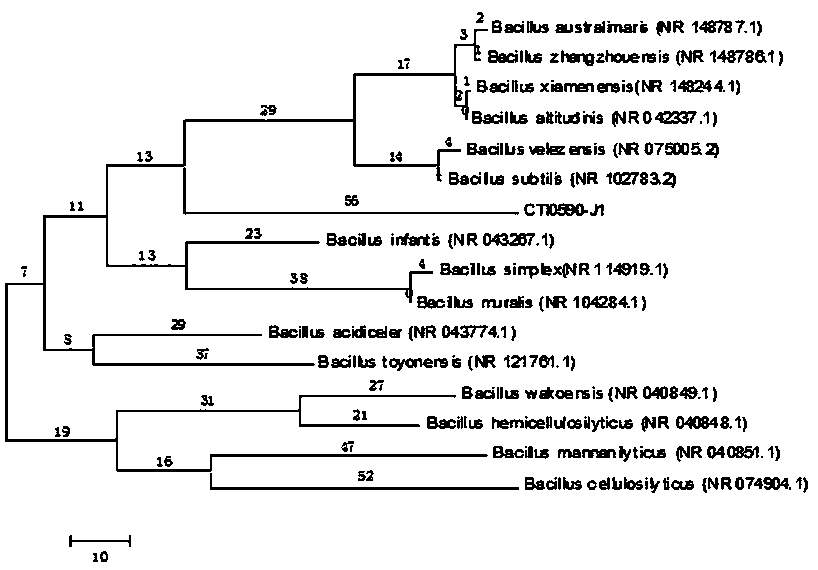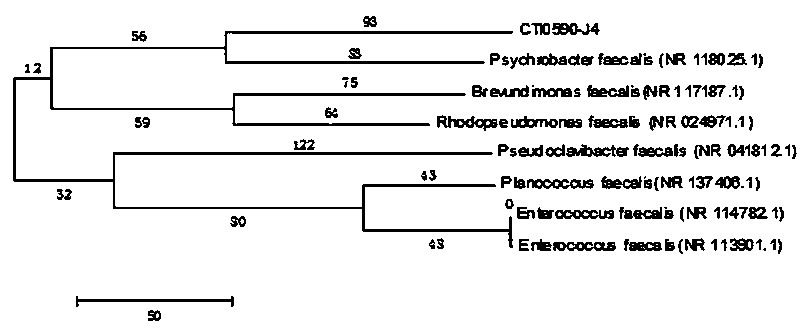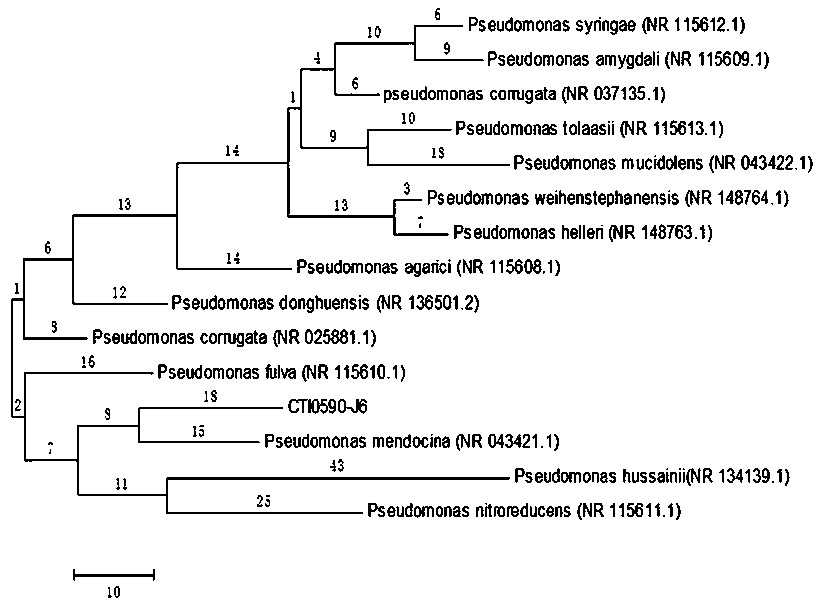Method for degrading oily wastewater through PAM (Polyacrylamide)-SA (Sodium Alginate) immobilized microorganisms
A technology of immobilizing microorganisms, PAM-SA, applied in microorganism-based methods, biochemical equipment and methods, microorganisms, etc., can solve the problems of poor anti-pollution ability, easy loss of bacterial cells, and low effective concentration.
- Summary
- Abstract
- Description
- Claims
- Application Information
AI Technical Summary
Problems solved by technology
Method used
Image
Examples
Embodiment 1
[0028] Isolation and identification of embodiment 1-bacterial strain:
[0029] Inoculate the petroleum aromatics-contaminated soil suspension with 15% inoculum amount into the nutrient solution with standard oil (6g / L) as the only carbon source, and culture it on a shaker at 150 r / min under aerobic conditions at 28°C for 3-4 days. Transfer 1 time under the condition. Dilute and apply to solid medium with petroleum hydrocarbon as the only carbon source, and culture at 28°C for 4-5 days to form a single colony. Pick colonies that grow rapidly and have neat edges and put them into the nutrient solution, and shake the flask for re-screening to obtain the target strain.
[0030] The identification results at the molecular biology level are shown in the nucleotide or amino acid sequence table.
[0031] 16s rDNA phylogenetic tree analysis, figure 1 Shown is the phylogenetic tree of the BS bacteria genus of the nucleotide or amino acid sequence SEQ1.
[0032] The Neighbor-Joining M...
Embodiment 2
[0037] The preparation of embodiment 2-microbial mixed inoculum:
[0038] 1. Inoculation and activation of microbial strains
[0039] Under sterile conditions, inoculate the four strains of BS, AFS, PSS and AS into the triangular flasks containing nutrient broth (after sterilization), and put the above triangular flasks into a shaker at 30°C and 200r / min. Cultivate in the bed for 48 hours and wait for use.
[0040] 2. Fermentation preparation of liquid mixed bacterial agent:
[0041] (1) The genus Bacillus ( Bacillus encimensis strain encimensis ), Alcaligenes faecalis ( Alcaligenes faecalis strain ), Pseudomonas citutzeri ( Pseudomonas stutzeri strain ), Acinetobacter ( Acinetobacter sp ), according to the amount of 5% incorporation into bacterial fermenters for fermentation and cultivation for 24 hours, to obtain bacterial seed liquid.
[0042] (2) Preparation of mixed bacterial agent:
[0043] The above fermented bacterial seed liquid is made into a bacterial s...
Embodiment 3
[0049] Embodiment 3-PAM-SA immobilized microorganism degrades oily wastewater:
[0050] 1. Technology of polyacrylamide (PAM)-sodium alginate (SA) immobilized microorganisms to degrade oily wastewater:
[0051] In this example, the fermented microbial agent prepared in Example 3 was used to repair the oily wastewater, and 5.0% of the immobilized microbial agent was added according to the volume ratio of the wastewater to repair the oily wastewater with a concentration of 1-3%.
[0052] The specific operation is as follows:
[0053] (1) Resurrection of four microbial strains, expanded cultivation, fermentation production, and standby;
[0054] (2) The combination of polyacrylamide (PAM)-sodium alginate (SA) as the embedding method to immobilize microorganisms is represented by PSM (Polyacrylamide-Sodium Alga Acid-Microorganism). Then use the prepared solid bacterial agent to mix evenly with oily wastewater, test the oil-reducing effect of the prepared material and discuss it....
PUM
 Login to View More
Login to View More Abstract
Description
Claims
Application Information
 Login to View More
Login to View More - R&D Engineer
- R&D Manager
- IP Professional
- Industry Leading Data Capabilities
- Powerful AI technology
- Patent DNA Extraction
Browse by: Latest US Patents, China's latest patents, Technical Efficacy Thesaurus, Application Domain, Technology Topic, Popular Technical Reports.
© 2024 PatSnap. All rights reserved.Legal|Privacy policy|Modern Slavery Act Transparency Statement|Sitemap|About US| Contact US: help@patsnap.com










